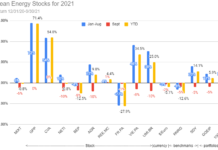by Jim Lane
In Washington, researchers for a report published by the Urban Air Initiative contend that “technical data that shows the nation has been exposed to decades of flawed test fuels and flawed driving tests, which in turn means flawed emissions results and mileage claims”. The complete Beyond a Reasonable Doubt series from UAI is available here.
Further, EPA emails obtained under the Freedom of Information Act reveal that, according to a report from Boyden Grey & Associates, the Agency appears to have directly solicited financial contributions and technical input, “especially on the fuel matrix,” from an oil industry controlled research organization.

Of the testing, Adam Gustafson of Boyden Grey & Associates wrote:
EPA relied heavily on the oil industry to design the matrix of test fuels used in an influential and deeply flawed fuel effects study known as the EPAct study. EPA invited this involvement from oil industry employees and from the Coordinating Research Council (“CRC”), a group funded by the oil industry. In exchange, EPA sought and received valuable in-kind support from the oil industry.
This new evidence of collusion between EPA and Chevron, BP, and CRC is important, because EPA used the results of the EPAct study to update its vehicular emissions model, MOVES2014, which States must use when they develop policies to comply with EPA’s air quality standards. As a result of the oil industry’s influence, the model reports that ethanol increases emissions of many pollutants, even though other studies have demonstrated the opposite. UAI and scientists from Ford, GM, and other organizations have shown the EPAct study and MOVES2014 model to be inaccurate and biased against ethanol. The documents UAI has obtained reveal the source of that bias—the petroleum industry’s direct influence on the design of the EPAct study’s test fuels.
Were the tests rigged to produce results?
Gustafson writes:
“EPA and its oil industry collaborators expected their test fuels to produce bad results for ethanol. When preliminary testing showed that higher ethanol fuels lowered emissions of nitrogen oxide and other pollutants, EPA considered “chang[ing] the program midstream” to obtain different results “[i]f we continue seeing no NOX effect.” In the end, EPA decided to exclude the relevant test fuels from the program, and otherwise altered its slate of test fuels to “emphasiz[e] ethanol effects.”
Decreased test robustness is allenged
After reviewing documentary evidence from EPA emails, Gustafson wrote:
“As a result of EPA’s changes to the design of its test fuels, to accommodate the oil industry, the statistical robustness of the experimental design decreased from a “G-efficiency” of 83.6% to a G-efficiency of 51.6%. Although EPA at first considered that only a design with G-efficiency above 60% would be satisfactory, the Agency lowered its minimum standard to 50% in response to the deteriorating quality of its design.”
#Dieselgate vs #Gasolinegate
In the #Dieselgate scandal, a defeat device was installed by employees of the Volkswagen Group in diesel-based vehicles to provide inaccurate emissions data for standard EPA-supervised road testing. The VW Group was fined more than $10 billion and diesel passenger vehicles sales have collapsed around the world.
In what we call “#Gasolinegate”, the defeat device is the fuel itself — special formulations of gasoline for which the Urban Air Initiative says that documentary evidence shows:
The EPA is relying on science that routinely and knowingly discounts the value of biofuels. Extensive research has shown that regulations are being implemented based on vehicle testing that use fake test fuels. But even if unbiased science was allowed to play out in these tests, the regulations that the EPA creates are prohibitive for any alternative to petroleum based fuel products.
How did it happen?
The UAI team reports:
Fearing that the U.S. corn ethanol industry would expand exponentially, the oil industry aligned with the environmental community to pressure EPA/OTAQ to derail the corn ethanol industry. It appears contradictory, but many key environmental groups focused more on land use issues and misguided net energy reports than clean fuels and clean air. As a result, they were convinced to oppose biofuels as a clean renewable fuel and octane source.
While at the same time, continued increasing toxic aromatics in the fuel supply. Random fuel samples collected from the Kansas City area in 2016, and sent out for testing by Urban Air Initiative (UAI), revealed benzene volumes as high as 2.1% and that does not account for benzene emissions that are formed by other aromatics compounds as they exit the tailpipe. This is nearly twice the legal limit.
This goes to show that Congressional intent is still not being followed and the general public is being exposed to even higher levels of toxic aromatics than allowed by law
What is benzene?
The Center for Disease Control writes:
“There is no safe exposure level to benzene; even tiny amounts can cause harm. The US Department of Health and Human Services (DHHS) classifies benzene as a human carcinogen. Long-term exposure to excessive levels of benzene in the air causes leukemia, a potentially fatal cancer of the blood-forming organs. In particular, acute myeloid leukemia or acute nonlymphocytic leukemia (AML & ANLL) is not disputed to be caused by benzene.
According to a Massachusetts Institute of Technology study, emissions from road transportation were the most problematic, causing approximately 53,000 premature deaths in 2005. The American Petroleum Institute (API) stated as early as 1948 that “it is generally considered that the only absolutely safe concentration for benzene is zero” There is no safe exposure level; even tiny amounts can cause harm.
The International Agency for Research on Cancer has stated:
“As benzene is ubiquitous in gasoline and hydrocarbon fuels are in use everywhere, human exposure to benzene is a global health problem. Benzene targets liver, kidney, lung, heart and the brain and can cause DNA strand breaks, chromosomal damage, etc. Benzene causes cancer in animals including humans. Benzene has been shown to cause cancer in both sexes of multiple species of laboratory animals exposed via various routes.”
The impact of PAH on children’s health
What is the health impact of polycyclic aromatic hydrocarbons, also known as PAHs? Dr. Linda Birnbaum, head of the National Institute of Environmental Health Sciences, told the Senate Environment and Public Works Committee in a 2010 hearing:
“In a 2009 study of the effects of PAH’s on children’s IQs in NYC…the mother’s exposure as measured during their pregnancies by wearing backpack monitors was associated with a decrease in IQ among the more exposed children. The extent of this exposure was similar to low-level lead exposure.”
Meanwhile, according to Terry Tamminen’s research in Lives per Gallon: The True Cost of our Addiction to Oil
“The Institute for Transportation Studies at the University of California at Davis places the minimum external cost of air pollution from motor vehicles in the U.S. at $24.3 billion each year. Their work and related studies suggest the costs may be far higher when values are added for things like early deaths and lost productivity.
Meanwhile, the Clean Air Act law requires EPA to do a cost benefit analysis every 20 years and periodically for different programs. EPA’s most recent study says for every $1 invested in reducing pollution the nation receives $30 in the form of reduced health costs.
The aromatics backstory: why are they in gasoline at all?
Gasoline is a complex compound of 450+ chemicals. About 20% to 30% of a gallon of gasoline contains toxic/carcinogenic aromatics, which are hydrocarbons derived from petroleum with one or several benzene ring-like molecular structure with a ‘sweet’ or aromatic odor.
Aromatics are additives to gasoline to raise its “octane” rating. Most gasoline stations carry three octane grades (87 Regular, 89 Mid-grade), 91-93 Premium). The most common aromatics include benzene, toluene methylbenzene, ethylbenzene, and xylene dimethylbenzene (often referred to as BTEX)
Octane is not only an expensive part of gasoline. To the extent “octane” is derived from crude oil, it is also can be most toxic and carbon-intensive. The use of higher octane fuels can enable auto makers to sell higher compression ratios, turbocharging, and downsizing/down speeding — all of which enable increases vehicle efficiency (miles per gallon) and lowers greenhouse gases through decreased petroleum consumption. For 100 years, auto manufacturers have searched for affordable, effective, and environmentally safe octane-boosting compounds, but there are only two commercially viable and legal contenders – aromatics and ethanol.
EPA’s role
The UAI team wrote in its report:
Emails between the EPA and the oil industry show that EPA asked oil industry employees what test fuels they would “prefer to see tested” and then revised the test fuels in response to their input. The EPA also threw out three test fuels after preliminary results showed that ethanol lowered emissions of nitrogen oxides and other pollutants and otherwise altered its slate of test fuels to downplay ethanol’s positive effects.
The emails show that the EPA relied heavily on oil industry employees from Chevron and BP to design the test fuels in a large-scale fuel effects study known as the EPAct vehicle study. This is important because the EPA used the results of the EPAct study to update its vehicular emissions model, MOVES2014. All States must use this emissions model to develop and implement plans for compliance with EPA’s air quality standards.
The process of simply adding ethanol to base gasoline is called splash blending. This is what happens in the “real” world and it is what should happen during fuel testing. However, when this is done, the results are not favorable to the oil industry. Simply adding ethanol to gasoline improves gasoline in every way. It lowers carbon, reduces common air pollutants for smog formation, lessens CO2 emissions, reduces sulfur content, and provides clean octane as a replacement for toxic aromatics. This was the exact intent of the Clean Air Act octane amendments.
Peer-reviewed confirmation on flawed testing
In the peer-reviewed journal article “Issues with T50 and T90 as Match Criteria for Ethanol-Gasoline Blends” James Anderson and Timothy Wallington of Ford Motor Company, Robert Stein of AVL Powertrain Engineering Inc., and William Studzinski of General Motors took issue with the EPA test methodology. They took particular issue with the use of a practice called “match-blending”, which they found creates the appearance of emissions attributed to ethanol which should be attributed to aromatics.
They wrote:
The purpose of this paper is to illustrate that exclusive use of a match blending approach has fundamental flaws. For typical gasolines without ethanol, the distillation profile is a smooth, roughly linear relationship of temperature vs. percent fuel distilled…For ethanol-gasoline blends, higher boiling-point hydrocarbons must be added to match…fuels having less ethanol. The degradation of emissions which can result is primarily due to the added hydrocarbons, but has often been incorrectly attributed to the ethanol.”
“EPA’s secret consultation “?
Boyden Grey’s Gustafson added:
EPA’s secret consultation with a group of oil company employees about the test fuel parameters violated the requirement of the Federal Advisory Committee Act and EPA’s Scientific Integrity Policy that such committees be balanced, that they be publicly announced and that their meetings be open to the public.
EPA’s exclusive reliance on oil industry employees with an incentive to generate results favorable to petroleum and disfavorable to ethanol violated the objectivity requirement of the Agency’s Information Quality Guidelines.122 It also violated EPA’s Scientific Integrity Policy, which requires all employees, including scientists and managers, to “[a]void conflicts of interest and ensure impartiality.”
EPA’s reliance on oil industry consultants was kept secret, in violation of the Scientific Integrity Policy’s requirement that scientific findings, be “generated and disseminated in a timely and transparent manner.”
The EPAct study contributed directly to the emissions factors in EPA’s new vehicular emissions model, MOVES2014, which State must use in constructing implementation plans for compliance with EPA’s air quality standards. EPA’s unlawful reliance on the oil industry to design the EPAct study compounds the agency’s failure to give the public notice and an opportunity to comment on the MOVES2014 model, as required by law.
Was there an alternative?
One legal and commercially-available and viable octane-boosting alternative to carcinogenic aromatics is ethanol. In 2008, A National Renewable Energy Laboratory report found:
Ethanol blending in the US is keeping US retail gasoline prices about 17 cents per gallon lower than they would be with no ethanol…with…an average ethanol concentration of 20 percent nationwide, the per-gallons savings (mileage adjusted) could reach 18 to 62 cants per gallon.
The UAI team writes:
One gallon of ethanol can replace up to two gallons of aromatics, which are the most carbon intensive and toxic of the 450+ chemicals in gasoline. Adding ethanol to gasoline allows refiners to reduce toxic/carcinogenic aromatics additives, which means a reduction in mobile source air toxics (MSATs) and ultrafine particles that create dangerous pollution and negative health effects. In addition, ethanol continues to improve its carbon footprint. According to the USDA, by 2022, ethanol’s GHG profile is expected to be almost 50% lower than gasoline due to improvements in corn yields and transportation efficiency, further improving air quality.
The Digest’s Take
In our view, this represents a substantial and compelling body of evidence that testing took place that apparently resulted in flawed data used in the EPA’s vehicular emissions model, and which would have materially underestimated the role and impact of renewable fuels in reducing carcinogenic emissions.
Further Reading
The 9-part series, Beyond a Reasonable Doubt, from the Urban Air Initiative, has links to all the cited sources.
- Part 1: Executive Summary.
- Part 2: The Problem.
- Part 3: The Threat.
- Part 4: What’s Been Done.
- Part 5: Why it’s Not Working.
- Part 6: Flawed Fuel Testing.
- Part 7: What We Can Do.
- Part 8: Biofuels, an Available Solution.
- Part 9: Conclusion.
Jim Lane is editor and publisher of Biofuels Digest where this article was originally published. Biofuels Digest is the most widely read Biofuels daily read by 14,000+ organizations. Subscribe here.








